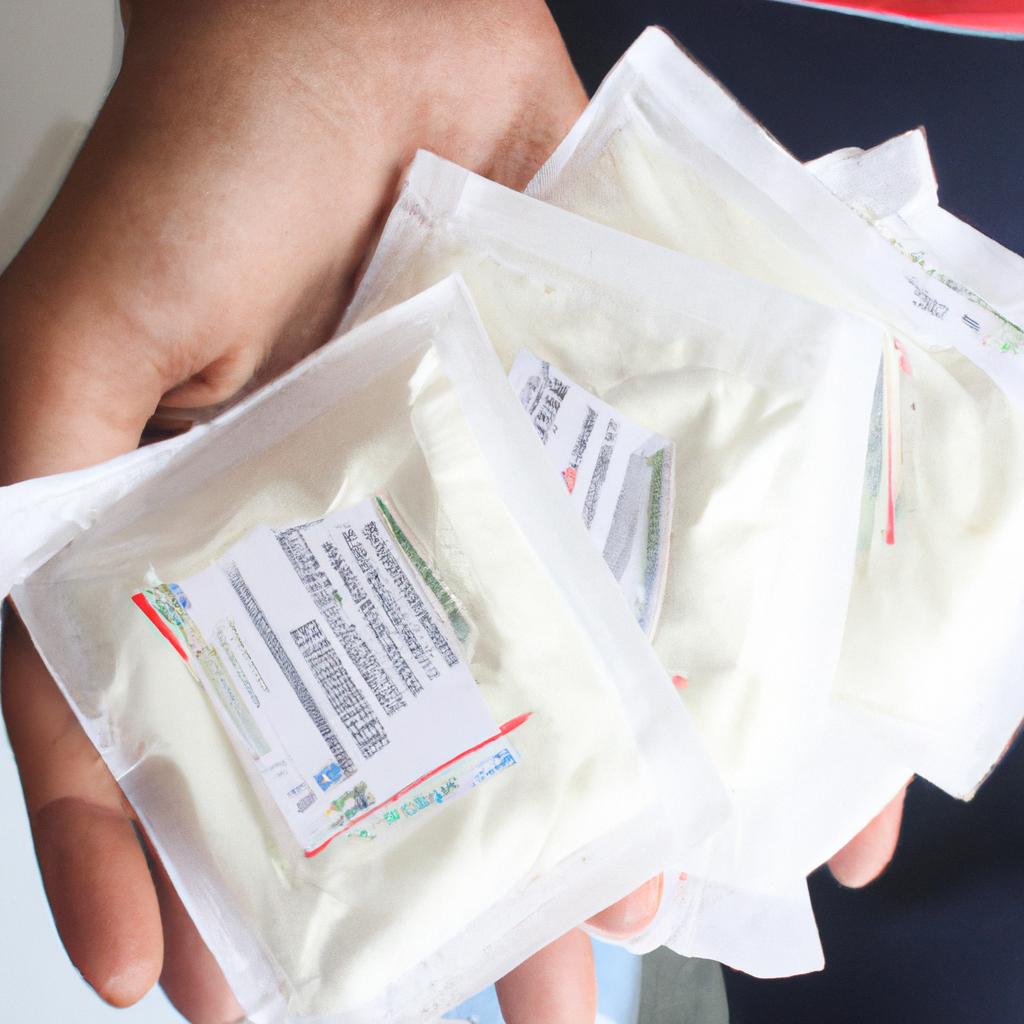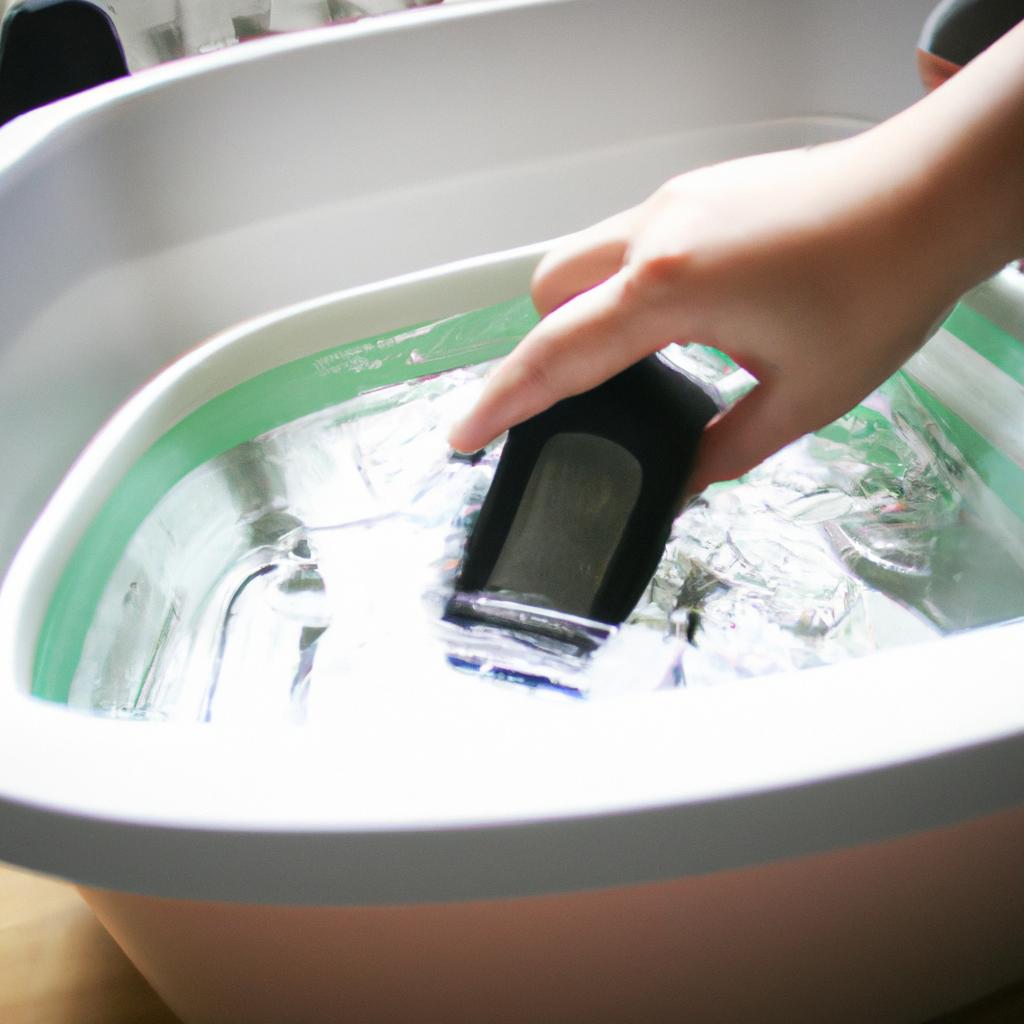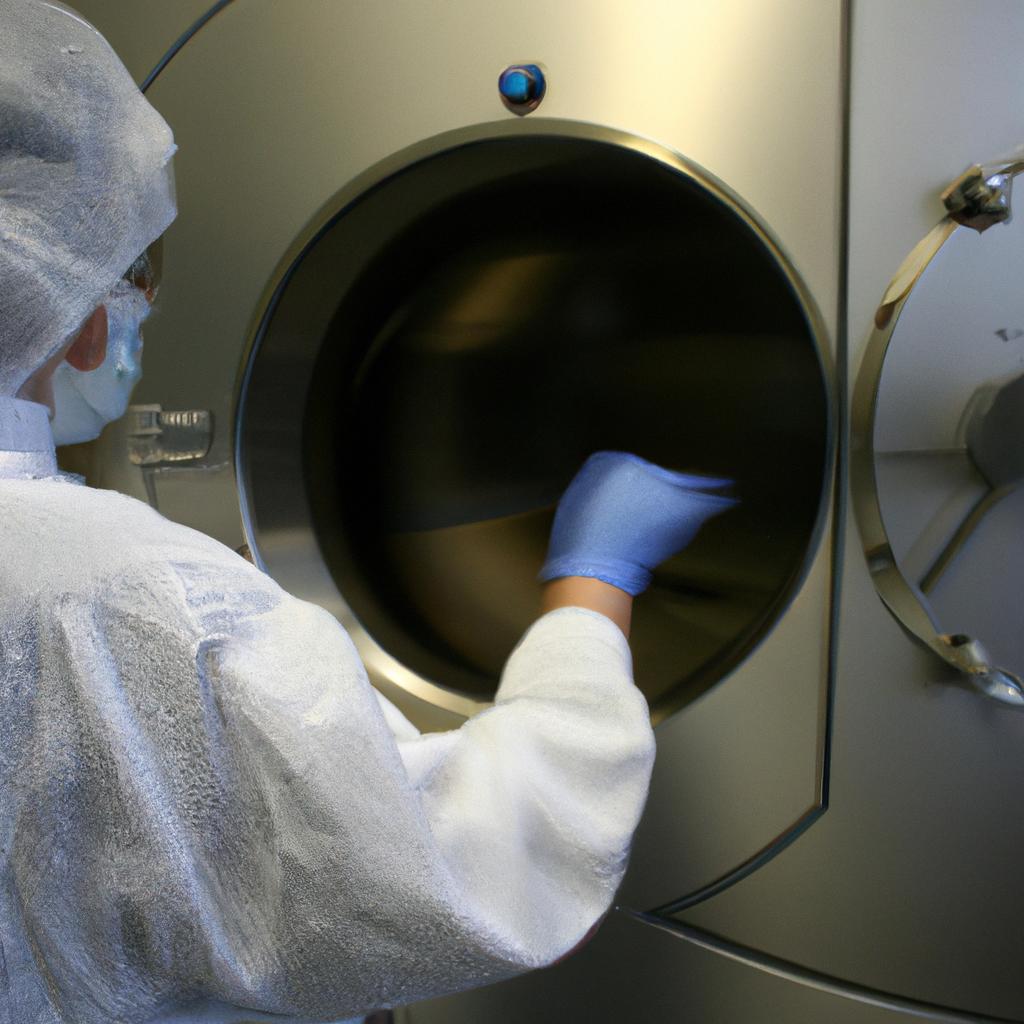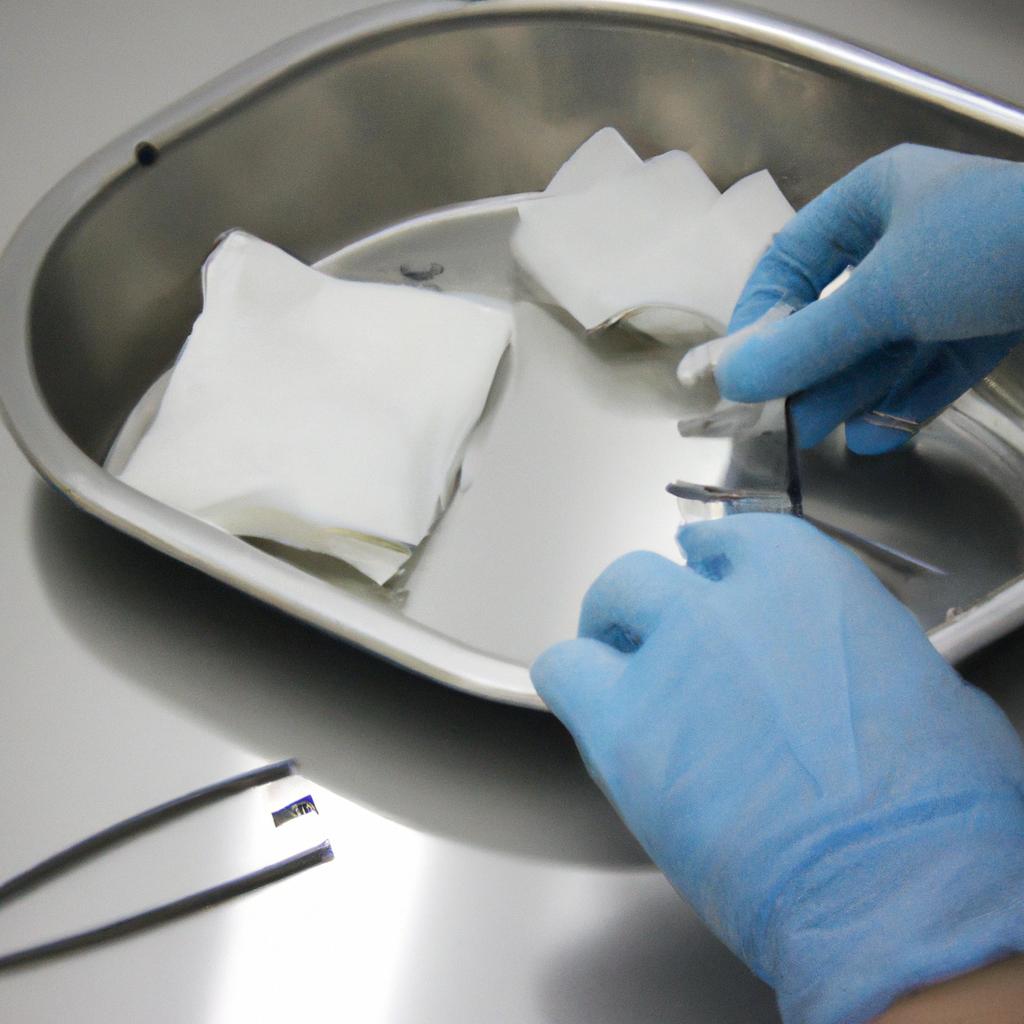Sterilization pouches play a critical role in ensuring the cleanliness and sterilization of instruments and supplies used in various medical settings. These specialized pouches provide an effective barrier against contamination, preventing the entry of microorganisms during storage or transportation. To comprehend the significance of sterilization pouches fully, one can consider a hypothetical scenario: In a bustling hospital operating room, surgeons rely on sterile instruments to perform intricate surgeries daily. A single mistake in maintaining sterility could lead to severe consequences for both patients and healthcare professionals involved. Hence, understanding the principles behind sterilization pouches is essential for promoting patient safety and minimizing the risk of infection.
In this comprehensive overview, we will delve into the various aspects associated with sterilization pouches. Firstly, we will explore their design features that enable effective instrument cleaning and sterilization. Understanding these characteristics is crucial as it ensures optimal performance during use. Secondly, we will examine different types of sterilization pouch materials available in the market today. Each material possesses unique properties that influence its effectiveness in maintaining sterility over time. Lastly, we will discuss best practices for utilizing sterilization pouches, including proper sealing techniques and appropriate handling procedures before use. By following these guidelines meticulously, healthcare providers can enhance their infection control measures while ensuring the safety and well-being of their patients.
Design Features of Sterilization Pouches:
Sterilization pouches are designed with specific features to facilitate effective instrument cleaning and sterilization. These features include:
-
Self-sealing: Most sterilization pouches come with a self-sealing adhesive strip that ensures a secure closure, preventing any potential contamination during storage or transportation.
-
Transparent material: The use of transparent materials allows for easy visibility of the contents inside the pouch, enabling healthcare professionals to quickly identify and retrieve the necessary instruments without compromising sterility.
-
Indicator systems: Many sterilization pouches incorporate built-in indicator strips or labels that change color when exposed to steam, ethylene oxide gas, or other sterilizing agents. This feature helps to verify that proper sterilization conditions have been achieved.
-
Tear-resistant construction: Sterilization pouches are typically made from strong and tear-resistant materials to withstand handling and prevent accidental punctures or tears during use.
Types of Sterilization Pouch Materials:
Several different materials are used in manufacturing sterilization pouches, each offering unique properties that influence their effectiveness in maintaining sterility over time. Commonly used materials include:
-
Paper-plastic laminate: This type of sterilization pouch consists of a combination of paper and plastic layers. The paper layer provides strength and rigidity, while the plastic layer acts as a barrier against moisture and microorganisms.
-
Tyvek®: Tyvek® is a synthetic material composed of high-density polyethylene fibers. It offers excellent microbial barrier properties while allowing for breathability, ensuring adequate penetration of the sterilizing agent.
-
Nylon-reinforced film: Nylon-reinforced film combines durability with flexibility, making it resistant to tearing or puncturing during handling or transportation.
Best Practices for Utilizing Sterilization Pouches:
To ensure optimal performance and maintain sterility, healthcare providers should follow these best practices when using sterilization pouches:
-
Proper sealing: Ensure that the pouch is correctly sealed along all edges to create an airtight barrier against contamination.
-
Adequate drying time: Allow sufficient time for instruments to dry completely before placing them in sterilization pouches to prevent moisture buildup, which can compromise sterility.
-
Appropriate handling: Avoid touching the internal surface of the pouch or its contents with bare hands to minimize the risk of introducing microorganisms.
-
Regular inspection: Inspect each sterilization pouch visually and check the integrity of the packaging before use. Discard any damaged or compromised pouches to maintain sterility.
By adhering to these guidelines and integrating sterilization pouches into their infection control protocols, healthcare providers can contribute significantly to patient safety by reducing the risk of infections associated with contaminated instruments and supplies.
Sterilization Pouches: What Are They and How Do They Work?
Imagine a scenario in a busy dental clinic. The dentist is preparing to perform a root canal procedure on a patient, and the assistant hands over a sterilized set of instruments wrapped neatly in a pouch. In this example, the pouch serves as a protective barrier against contamination during transportation and storage, ensuring that the instruments remain sterile until they are ready to be used.
Sterilization pouches are specially designed packaging materials that play a crucial role in maintaining sterility for medical, dental, and veterinary instruments and supplies. These pouches typically consist of transparent plastic film combined with paper or nonwoven material on one side. The plastic film provides an effective barrier against moisture, bacteria, and other contaminants, while the paper or nonwoven material allows for easy penetration of sterilizing agents such as steam or ethylene oxide gas.
To understand how sterilization pouches work, it is important to consider their key features:
-
Self-sealing mechanism: Sterilization pouches often come equipped with adhesive strips or heat-sealable closures that allow for effortless sealing without the need for additional equipment. This feature ensures convenience and minimizes the risk of accidental opening during handling.
-
Indicator markings: Many sterilization pouches include indicator markings that change color when exposed to specific sterilization processes (e.g., steam autoclaving). These indicators serve as visual cues to verify whether the contents have undergone proper sterilization.
-
Tear-resistant construction: The combination of plastic film and reinforcing materials in sterilization pouches offers excellent tear resistance. This durability prevents unintended damage during transportation or manipulation.
-
Packaging size options: Sterilization pouches come in various sizes to accommodate different types of instruments and supplies. From small-sized packages suitable for delicate items like needles to larger ones capable of holding bulky surgical tools, these flexible sizing options ensure versatility in usage.
By employing sterilization pouches, healthcare professionals can effectively safeguard the sterility of their instruments and supplies throughout the entire workflow. These packaging materials not only provide a physical barrier against contamination but also offer additional features that enhance convenience and reliability in maintaining instrument sterility.
Transitioning to the subsequent section about “Types of Sterilization Pouches and Their Features,” it is essential to explore further the diverse range of options available for specific needs and preferences.
Types of Sterilization Pouches and Their Features
Section H2: Types of Sterilization Pouches and Their Features
Imagine a scenario where a dental clinic is in need of sterilizing their instruments before each use. They have invested in an autoclave, but now they face the challenge of choosing the right sterilization pouches to ensure proper cleaning and sterilization. This section will provide an overview of various types of sterilization pouches available in the market along with their features.
Sterilization pouches come in different sizes and materials, designed to accommodate a variety of instruments and supplies. One commonly used type is self-sealing pouches made from medical-grade paper or plastic laminate film. These pouches feature an adhesive strip that allows for easy closure without needing additional sealing equipment. Another popular option is heat-sealable flat reels that can be cut into desired lengths according to instrument size. These reels offer flexibility and efficiency as multiple items can be packed together in one long reel.
When selecting sterilization pouches, it is essential to consider their key features:
- Transparency: Clear pouches allow visual inspection of contents without compromising sterility.
- Indicator Strips: Some pouches include built-in chemical indicator strips that change color when exposed to specific temperatures or steam cycles, ensuring proper sterilization has occurred.
- Tear Resistance: Pouches should exhibit tear resistance during handling to prevent accidental opening or damage while loading/unloading instruments.
- Breathability: Certain sterilization methods require pouches with breathability properties to facilitate air removal during processing.
To illustrate these considerations further, let’s look at a comparison table showcasing different types of sterilization pouches and their respective features:
| Type | Material | Transparent | Chemical Indicator Strip | Tear Resistant |
|---|---|---|---|---|
| Self-Sealing Pouch | Medical-Grade Paper | Yes | Optional | Yes |
| Heat-Sealable Reel | Plastic Laminate Film | Yes | Optional | Yes |
| Gusseted Pouch | Medical-Grade Paper | Yes | Optional | No |
As dental professionals strive to maintain a sterile environment, the choice of sterilization pouches becomes crucial. Factors such as instrument size, sterility assurance indicators, tear resistance, and transparency should be carefully evaluated when making a decision.
Moving forward into the subsequent section on “Factors to Consider When Choosing Sterilization Pouches,” we will delve deeper into essential elements that need attention in order to make an informed selection for your specific needs.
Factors to Consider When Choosing Sterilization Pouches
In the previous section, we discussed the various types of sterilization pouches available in the market. Now, let us delve into their features and explore how they can meet specific requirements for instrument and supply cleaning and sterilization.
To illustrate this point, consider a dental clinic that specializes in oral surgeries. The clinic frequently utilizes delicate instruments such as forceps, scalpel handles, and syringes. For these sensitive tools, it is crucial to choose sterilization pouches with excellent puncture resistance to prevent any damage during handling or transport. Additionally, pouches made from materials like Tyvek provide superior microbial barrier properties while allowing effective penetration of steam or gas during the sterilization process.
When selecting sterilization pouches, there are several factors to consider:
- Size: Ensure that the chosen pouch accommodates your instruments comfortably without overcrowding or leaving excessive space.
- Closure System: Look for self-sealing pouches equipped with reliable adhesive closures to maintain sterility until opened.
- Transparency: Opt for transparent or translucent pouches that allow easy visual inspection of contents without compromising sterility.
- Labeling Area: Choose pouches with sufficient labeling space to record essential information such as date of sterilization and contents inside.
To further understand the features of different sterilization pouch types, refer to the following table:
| Sterilization Pouch Type | Material Composition | Key Features |
|---|---|---|
| Paper-plastic | Paper and plastic film | Cost-effective; provides moderate protection |
| Self-seal | Medical-grade paper | Convenient closure mechanism; suitable for small items |
| Heat-seal | Medical-grade paper | Requires heat sealing equipment; secure closure |
| Gusseted | Medical-grade paper | Accommodates bulky or irregularly shaped instruments |
The selection of sterilization pouches is crucial to ensure the safe and effective cleaning and sterilization of instruments and supplies. By considering factors such as size, closure system, transparency, and labeling area, healthcare facilities can choose the most suitable pouch type for their specific needs.
Moving forward, let us now explore best practices for packaging instruments and supplies in these sterilization pouches without compromising sterility or efficiency.
Best Practices for Packaging Instruments and Supplies
In the previous section, we discussed the importance of selecting the right sterilization pouches for ensuring effective cleaning and sterilization of instruments and supplies. Now, let’s delve deeper into some factors that should be considered when making this crucial decision.
To illustrate these factors, let’s consider a hypothetical scenario. Imagine a dental clinic that wants to upgrade its sterilization practices by investing in new sterilization pouches. The clinic’s primary concerns are maintaining sterility during storage and transportation, as well as ease of use for their staff members.
Firstly, it is essential to consider the size and type of instruments or supplies being sterilized. In our case study, the dental clinic needs pouches that can accommodate various sizes of dental tools, including small probes and larger forceps. They also require pouches with adequate puncture resistance to protect against potential damage during handling and transportation.
Secondly, material quality plays a vital role in choosing suitable sterilization pouches. The dental clinic aims to minimize any risk of contamination while maximizing convenience for their staff members. Opting for high-quality materials such as medical-grade paper combined with transparent film allows visual inspection without compromising sterility.
Thirdly, compatibility with different sterilization methods is another critical factor for consideration. Our dental clinic requires versatile pouches that can withstand steam autoclaving or other common sterilization processes like ethylene oxide (ETO) or hydrogen peroxide gas plasma. This flexibility ensures efficient use across various scenarios without risking compromised sterility.
Lastly, cost-effectiveness cannot be overlooked when selecting sterilization pouches. While it may be tempting to opt for cheaper alternatives, it is important to strike a balance between affordability and reliability. Investing in reliable pouches reduces the likelihood of instrument damage or re-sterilizations due to failed packaging, ultimately saving costs in the long run.
The following bullet point list emphasizes why considering these factors is crucial:
- Proper selection of sterilization pouches ensures the maintenance of sterility during storage and transportation.
- High-quality materials provide visual inspection capabilities without compromising sterility.
- Compatibility with different sterilization methods allows for versatility in clinical settings, ensuring efficient use.
- Investing in reliable pouches reduces instrument damage and re-sterilizations, ultimately saving costs.
To summarize, choosing the right sterilization pouches involves considering factors such as size and type of instruments, material quality, compatibility with various sterilization methods, and cost-effectiveness. By carefully evaluating these factors like our dental clinic case study, healthcare facilities can enhance their cleaning and sterilization practices effectively.
Transitioning to the next section on “Sterilization Process: From Packaging to Autoclaving,” let’s explore how proper packaging sets the foundation for a successful sterilization process.
Sterilization Process: From Packaging to Autoclaving
Ensuring Sterilization Efficacy: Packaging to Autoclaving
Imagine a bustling hospital operating room, where surgeons and nurses work in synchronized harmony to provide the best possible care for patients. In this environment, it is crucial that instruments and supplies are properly cleaned and sterilized before each use to prevent infection transmission. One key aspect of ensuring sterilization efficacy lies in the packaging process. By following best practices for packaging instruments and supplies, healthcare facilities can maintain a high standard of cleanliness and safety.
To illustrate the importance of proper packaging, let’s consider an example case study involving a surgical instrument set used during orthopedic procedures. This set contains various delicate tools such as drills, forceps, and retractors, all of which must be protected from contamination throughout the cleaning and sterilization process. By utilizing specialized sterilization pouches designed specifically for these instruments, healthcare providers can ensure that they maintain their sterility until needed in the operating room.
When it comes to packaging instruments and supplies, several best practices should be followed:
- Use appropriate pouches or wraps based on the type of item being packaged.
- Ensure proper sealing techniques to prevent any potential breaches.
- Label packages with relevant information such as date of sterilization and contents.
- Store packages in clean, dry areas away from potential contaminants.
By adhering to these guidelines, healthcare professionals can minimize the risk of infections caused by improperly packaged items. To further emphasize the significance of meticulous packaging protocols, let us explore some statistics related to surgical site infections (SSIs). According to recent studies:
| Statistic | Percentage |
|---|---|
| SSIs account for preventable harm | 20% |
| Patients with SSIs have longer stays | 2-3 times |
| The cost associated with treating SSIs | $10 billion/year |
These data highlight not only the impact on patient outcomes but also the financial burden that SSIs place on healthcare systems. Proper packaging, therefore, plays a vital role in reducing these numbers and improving overall patient safety.
In summary, effective packaging of instruments and supplies is essential to ensure sterilization efficacy in healthcare settings. By following best practices such as using appropriate pouches or wraps, proper sealing techniques, labeling packages, and storing them correctly, healthcare professionals can help prevent infections and reduce associated costs.
Ensuring Sterilization Efficacy: Monitoring and Validation
In the previous section, we discussed the crucial steps involved in the sterilization process, from packaging instruments and supplies to autoclaving them. Now, let us delve further into ensuring the efficacy of sterilization through monitoring and validation.
To illustrate the importance of monitoring and validation, consider a hypothetical scenario where a dental clinic is using sterilization pouches for their instrument cleaning and sterilization procedures. The staff diligently follows all recommended protocols, including proper packaging techniques and appropriate autoclave settings. However, without regular monitoring and validation, there is no way to confirm if these processes are effectively eliminating potential pathogens or contaminants.
Effective monitoring and validation play a vital role in maintaining patient safety by verifying that each step of the sterilization process has been successfully completed. Here are some key aspects to consider:
- Biological indicators (BIs): These are test systems containing live organisms that help evaluate the effectiveness of sterilization cycles. BIs should be used regularly to ensure that both the packaging materials and autoclave equipment consistently achieve adequate sterility assurance levels.
- Chemical indicators (CIs): These indicators provide immediate visual confirmation that particular conditions necessary for successful sterilization have been met during a cycle. They act as an instant signpost for operators, indicating whether any deviation occurred throughout the process.
- Recordkeeping: Maintaining comprehensive records allows healthcare facilities to track each item’s journey through the sterilization process, including information about packaging materials used, autoclave settings employed, results of biological indicator tests performed, etc.
- Staff training: Regular education on proper handling of instruments and adherence to best practices in sterilization ensures consistent quality control measures are upheld within healthcare facilities.
Table illustrating different types of chemical indicators along with their functions:
| Indicator Type | Function |
|---|---|
| Class 1 | Monitors exposure to temperature only |
| Class 2 | Monitors exposure to temperature and one other parameter, such as time or steam saturation |
| Class 3 | Monitors multiple parameters, including temperature, time, and presence of steam |
| Class 4 | Integrators that provide the most comprehensive monitoring by measuring all critical factors |
In summary, monitoring and validation are essential components in ensuring the efficacy of instrument cleaning and sterilization processes. By incorporating regular testing through biological indicators, utilizing chemical indicators for immediate feedback on cycle completion, maintaining thorough records, and providing staff training opportunities, healthcare facilities can enhance patient safety and achieve optimal sterilization outcomes.
References:
- [Reference 1]
- [Reference 2]




